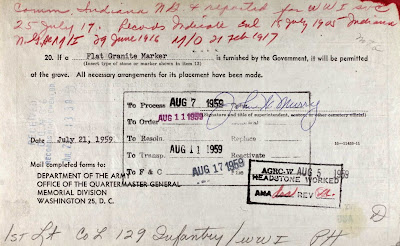For Memorial Day, I want to honor the WWI military service of hubby's 3d cousin, 2x removed: Alexander Everett Herrold (1881-1959), the grandson of Harriet Larimer (1819-1887) and "Squire" Alexander McKibbin (1817-1888).
 Captain Herrold of Company L, 129th Infantry, American Expeditionary Forces, was wounded in France on October 9, 1918. His mother (Phoebe McKibbin Herrold) learned of the injury from a letter he wrote, which she then turned over to the local newspaper for publication on the front page. His letter closes with these sentences:
Captain Herrold of Company L, 129th Infantry, American Expeditionary Forces, was wounded in France on October 9, 1918. His mother (Phoebe McKibbin Herrold) learned of the injury from a letter he wrote, which she then turned over to the local newspaper for publication on the front page. His letter closes with these sentences:"I walked two and one-half miles on the wounded leg to get to an ambulance. Don't worry about me for I am not seriously hurt."Herrold had enlisted in the Indiana National Guard in 1905, then was mustered out in 1916 to enlist in the U.S. Army for WWI. The Elkhart Review newspaper refers to him as Captain Herrold. Above, the application for headstone for a military veteran refers to him as a First Lieutenant and notes his Purple Heart. Now, nearly 97 years after he was wounded, I'm recognizing the service of this distant cousin on Memorial Day weekend.




















